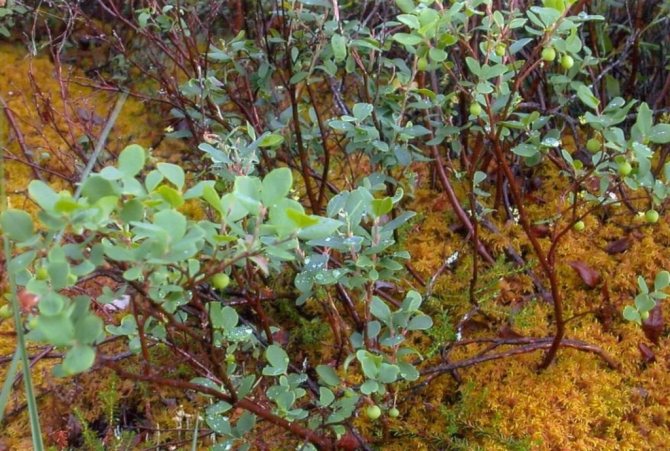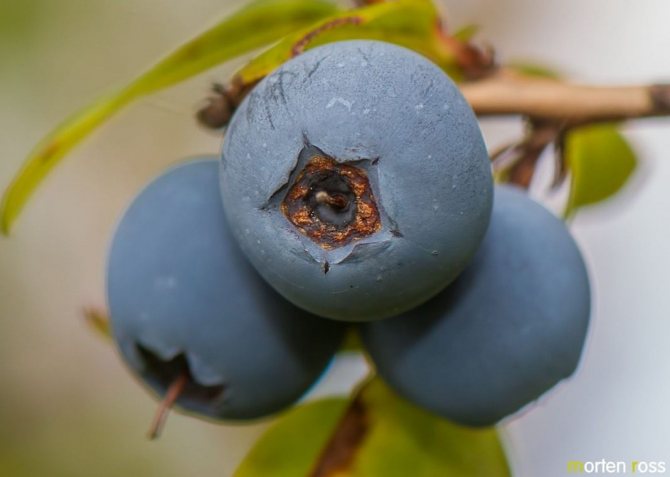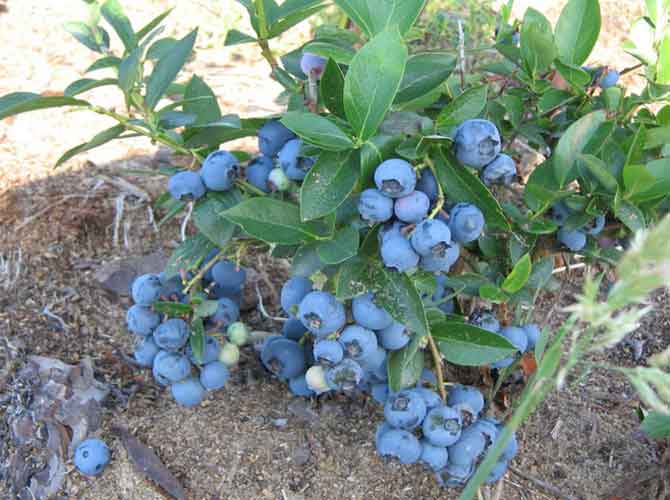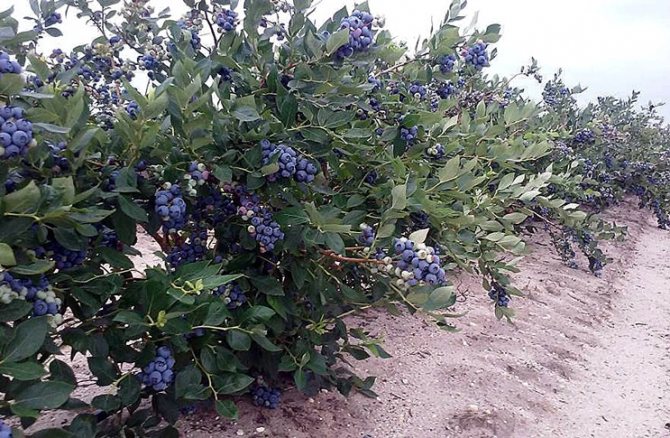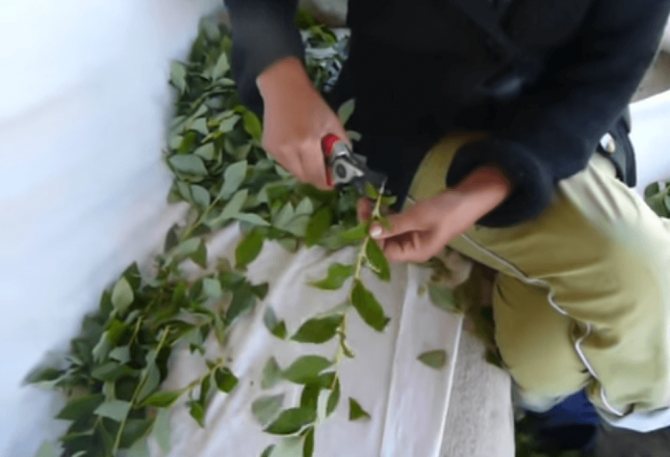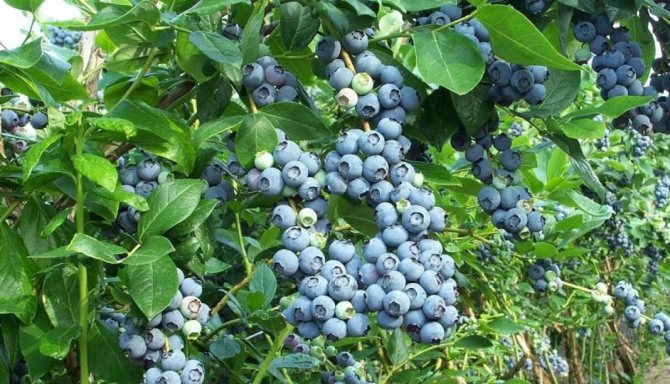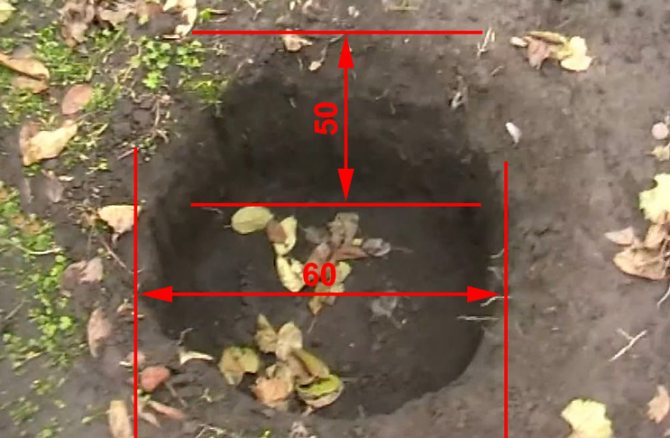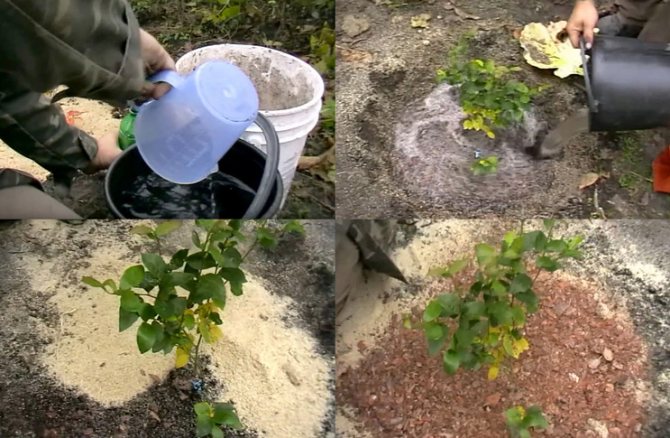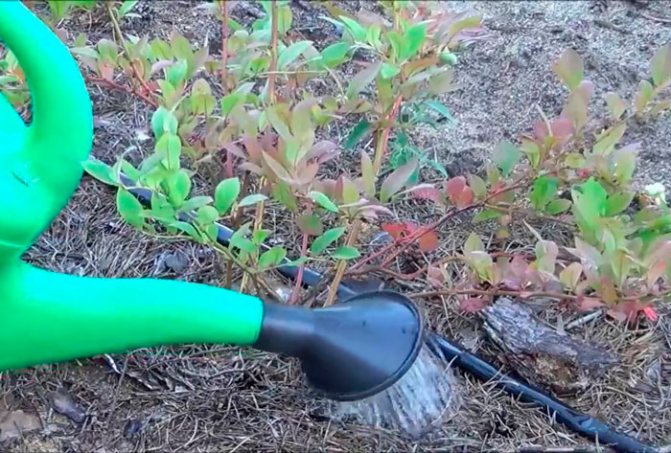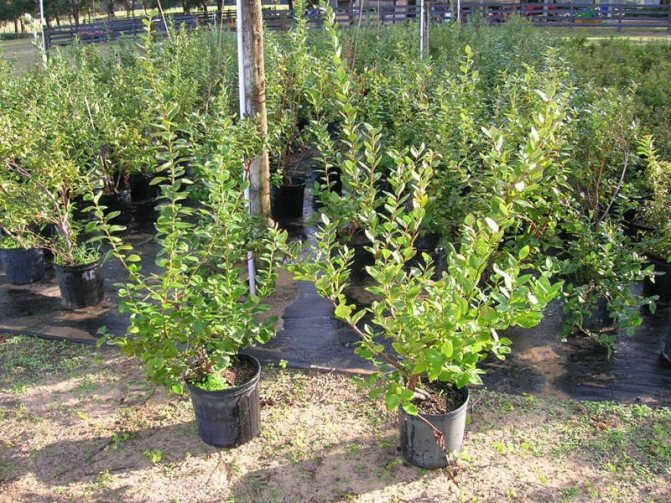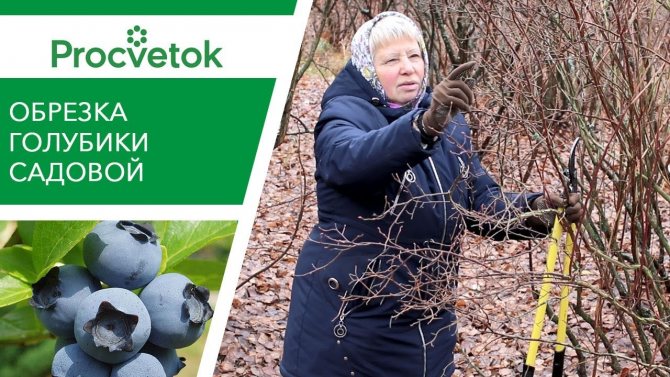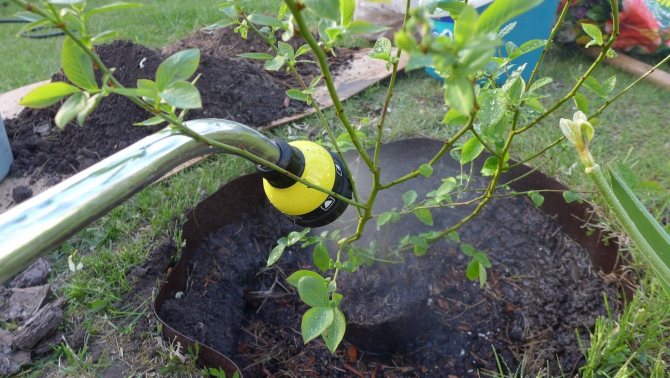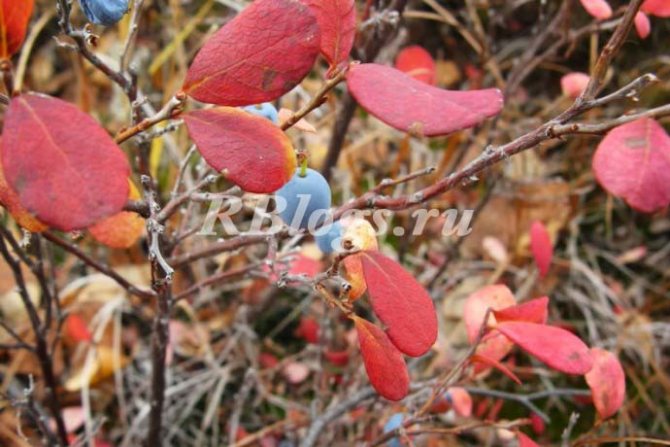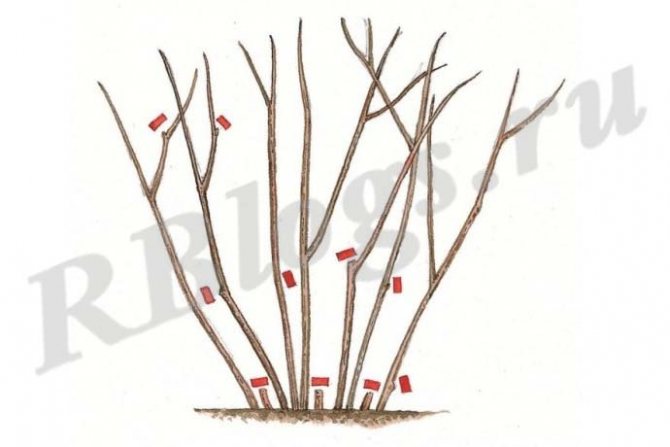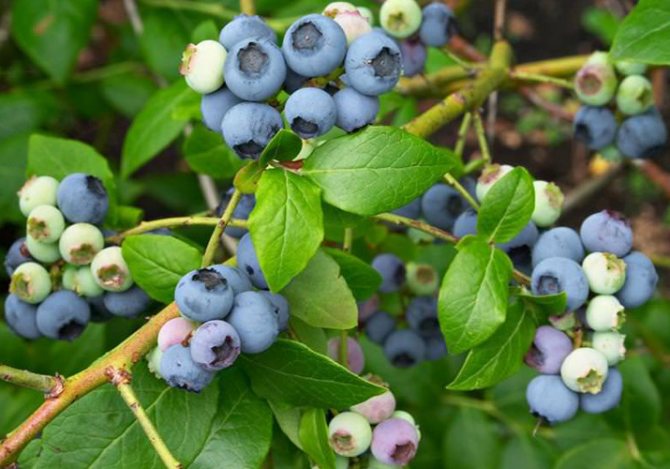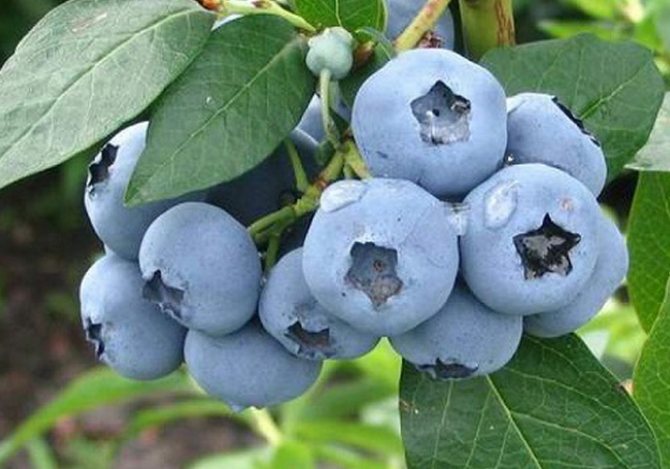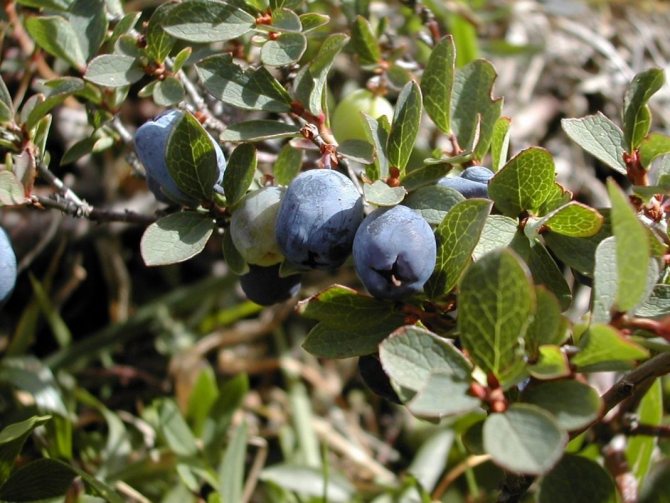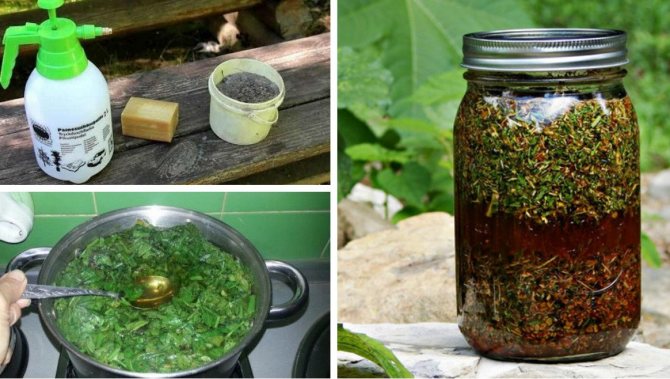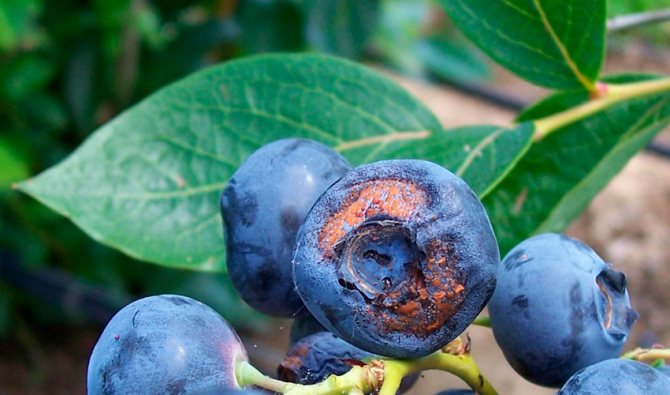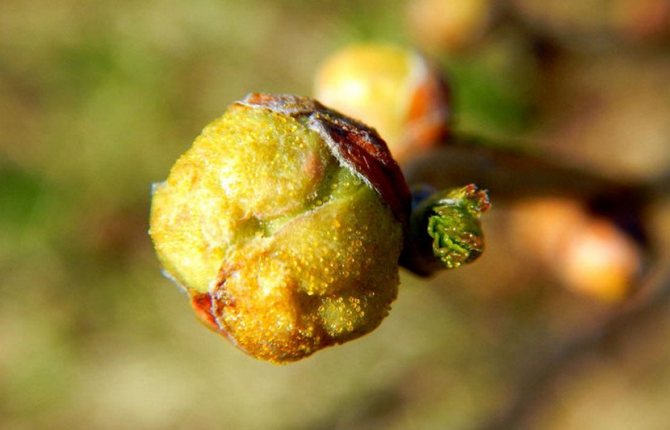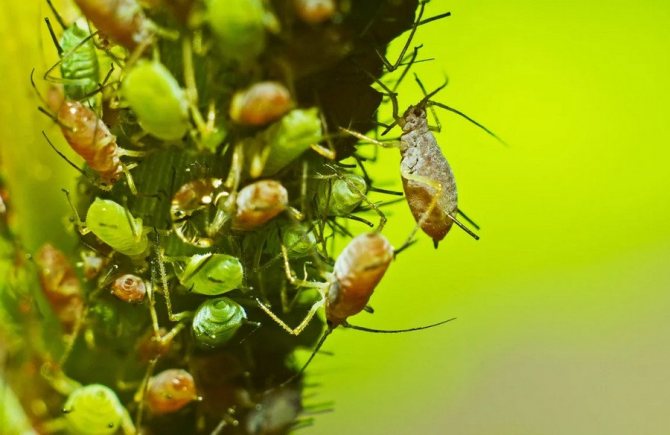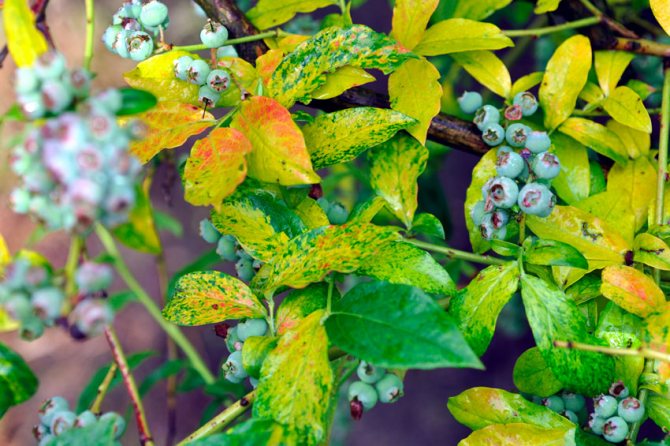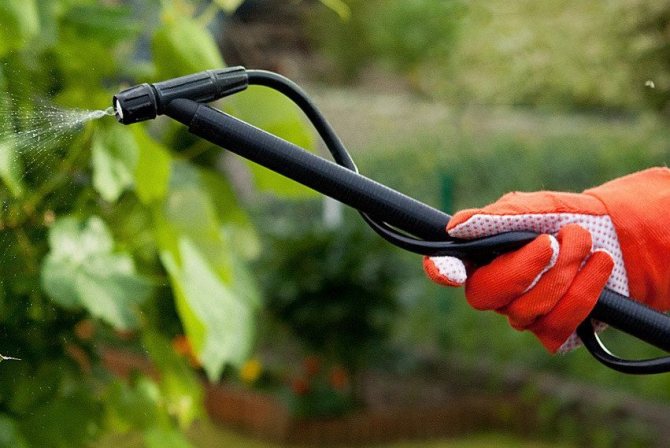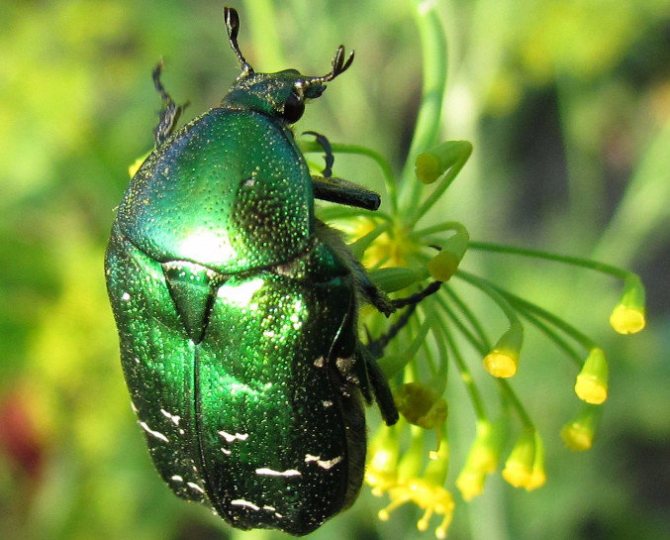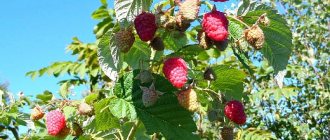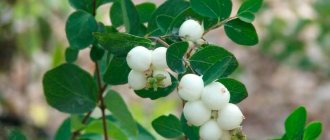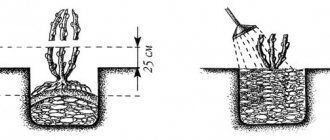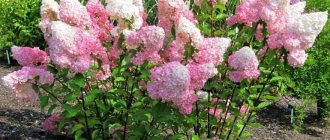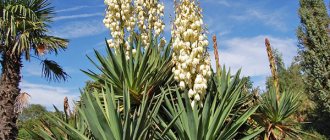Garden blueberry is a tall, deciduous shrub native to North America. Unlike cold-tolerant species, American-bred blueberries are suitable for temperate and warm climates. The bush reaches a height of two meters and produces up to 10 kg of berries, which makes it cost-effective to grow blueberries even in the country or in the garden.
Planting and caring for garden blueberries is not very difficult. The plant is demanding on the composition of the soil, warmth and light. All these needs must be taken into account immediately, when choosing a site, because blueberries are a long-liver, and can grow and bear fruit in one place for several decades.
Description of garden blueberry
Blueberries are a fairly large bush, the height of which fluctuates between two to two and a half meters. Most often highly branched. Leaves reach 10-12 cm in length and more than 6 cm in width. Shrubs are quite unpretentious when breeding, however, one should take into account the variety of varieties and plant the most optimal in a particular area.
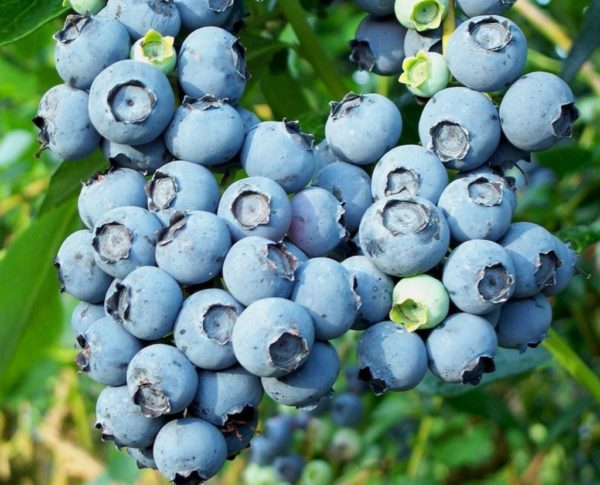
Ripe fruits
What varieties exist:
- "Bluecrop" is considered mid-season, it is often called one of the standard and most common varieties. Bushes of medium size - rarely exceed two meters. The characteristic large fruits (from 14 mm) are collected in small clusters. The approximate annual collection is 6-9 kilograms per plant. The blueberry variety is quite frost and drought resistant. By the end of summer, the fruits can already be harvested;
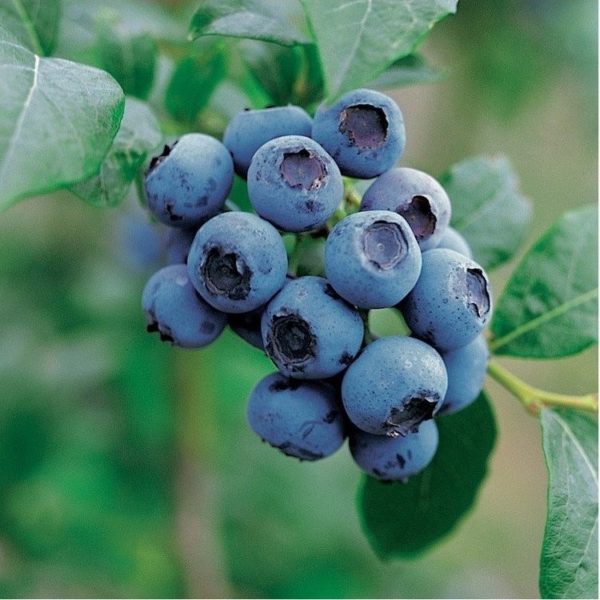

Bluecrop
- "Spartan" is a late-ripening variety. Its height is about one and a half to two meters. The fruits are large - 15-17 mm. They are characterized by a special aroma and excellent taste. Their ripening ends at the end of August. An important feature is that shrubs can hardly tolerate waterlogging. From one bush, you can get about 4-7 kilograms of fruit;


Spartan
- "Blue Ray" is another mid-season variety, the height of which ranges from 1 to almost two meters. Berries are light blue (large) - about 21 mm, weight of one - on average 2 grams. The fruits ripen by mid-July. The duration of fruiting is one to two weeks. About 5-8 kg of berries are "removed" from one bush. This variety is one of the most frost-resistant;
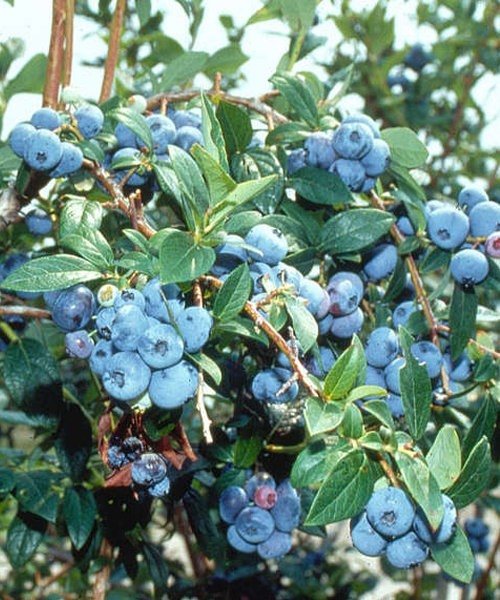

Blue Ray
- "Duke" is an early variety, the bushes grow about two meters in length. The berries are large - up to 20 mm in diameter. Most often, the berry is used for freezing (it is believed that after cooling the taste improves) or consumed immediately after harvest. Fruiting begins in July. Harvest from one bush - about 8 kg. The variety tolerates frost well;
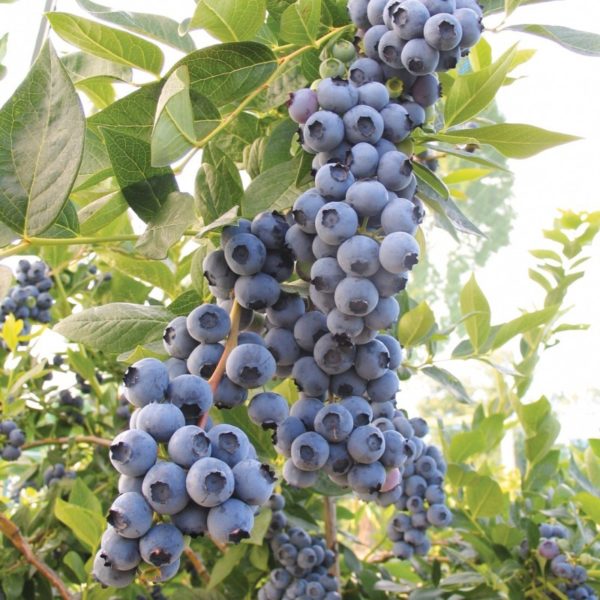

Duke
- "Patriot" belongs to the middle early cultures. The berries are slightly flattened, their size is 15-19 mm. Unripe fruits have a characteristic reddish tint. The bushes are not afraid of frost (the temperature below -30 C is not critical for them), they are not susceptible to fungal ailments (for example, stem cancer, root rot). The crop can be harvested as early as July;
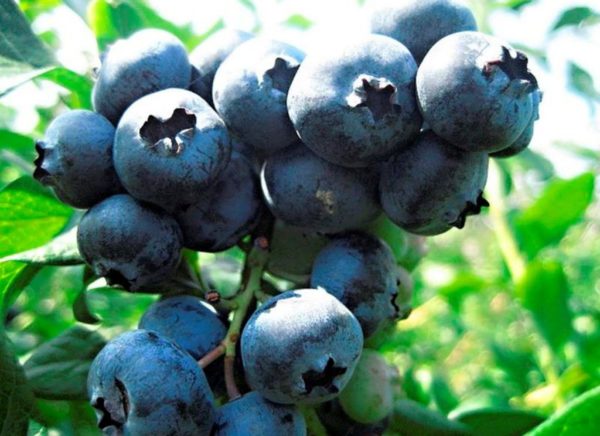

Patriot
- "Berkeley" refers to the late maturing varieties. The height of the shrub may be slightly more than 2 meters, it is characterized by strong branching. The berries are of different sizes - 14-19 mm, due to their strength, they easily tolerate long-term transportation. Ripening occurs in the second half of August. The variety tolerates temperature extremes well, as well as excess moisture in the soil.From one shrub, you can get from 4 to 7-8 kg of fruits;
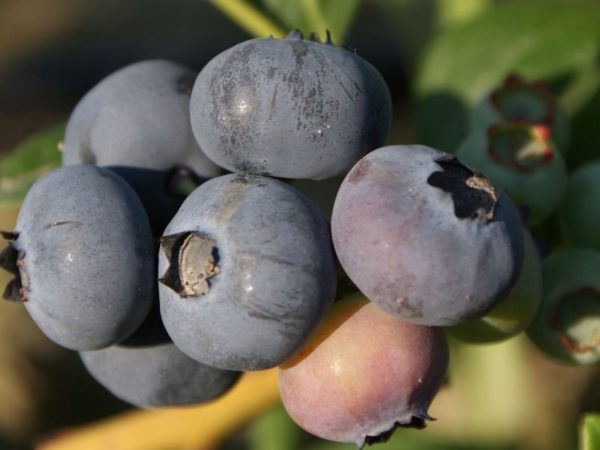

Berkeley
- Earley Blue is considered one of the earliest - by the end of June it is already possible to harvest. Large, light blue, slightly flattened berries weigh just under 2 grams. The average yield is about 4-7 kg per shrub. It is worth noting that the berries stay on the branches for a long time, even after full ripening. Long-term storage is not recommended.
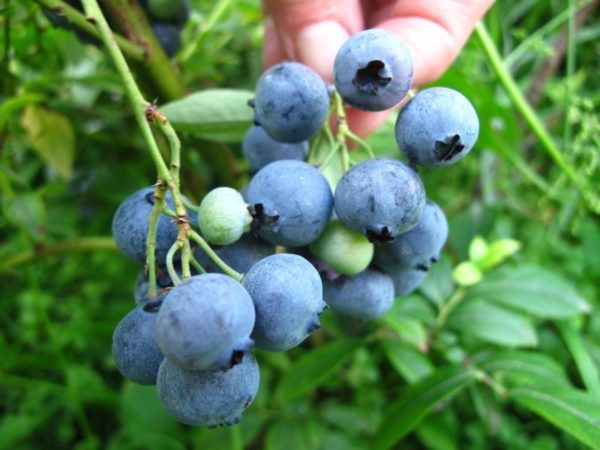

Earley Blue
It should be noted that shrubs can live up to hundreds of years. Blueberries make delicious jams, but most often the berries are mixed with other fruits (for example, blueberries or cranberries). Interestingly, blueberry juice will not stain fabrics after drying.


Wintering
Garden blueberries are highly frost-resistant. The plant can comfortably tolerate air temperatures down to -25 oC. Preparation for winter is required only when growing this crop in the northern regions. To do this, 2-3 weeks before the beginning of return frosts, the area of the near-stem circle is mulched with peat or sawdust with a layer of up to 7 cm.The plant is covered with agrofibre or non-woven material, the protection must be removed in the spring after the first signs of warming.
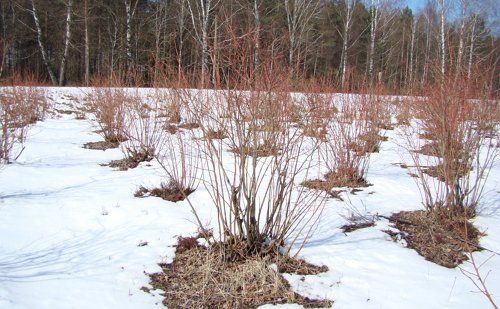

How to plant blueberries correctly?
Planting features are associated with the fact that the shrub thrives in acidic soil (pH from 3.5, but not more than 5.5), but most crops do not tolerate such acidity, so the blueberry zone will have to be specially prepared. The roots of the bushes are located close to the surface of the earth, so that the culture can develop normally, the soil should not impede the flow of water and air. Ideal Soil Types for Use:
- sour peat plus sand additive;
- land from pine forests;
- sandy loam.
Clay types are completely unsuitable for planting.
It is important to plant bushes in a well-lit place, otherwise the development of culture will be difficult. But at the same time, due to the fact that the bushes are quite tall, it is recommended to provide protection from the wind, otherwise they may die in winter. It is best to build a low hedge or fence.
You should monitor the constant moisture of the soil - water the soil about 2-3 times a day. The planting process is most often carried out in the spring, so that the plants start up roots and get stronger long before the onset of cold weather.
The procedure comes down to several stages:
Step 1
Preparation - digging a well or a trench with a depth of about half a meter, width - from 1/2 to one and a half meters. The side surfaces can be laid with polyethylene (but not the bottom).


Landing trench
Step 2
Filling up the earth with the required acidity. The most optimal solution is high moor peat (you can still use sphagnum peat), mixing it with clean sand, sawdust of needles and small branches. You can not add manure, as well as other additives rich in alkali.
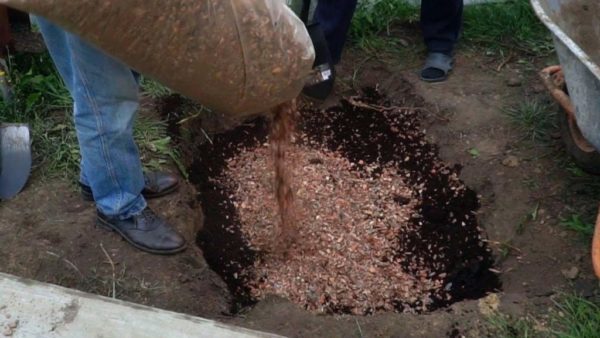

Earth filling
Important: if the local soil is clay, you will have to make a high bed, otherwise the accumulating water will damage the bushes.
Step 3
The vessel with the plant must be soaked in water for half an hour so that the roots are saturated with moisture.
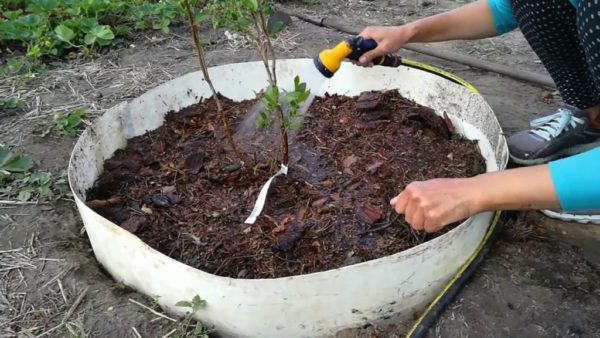

Moisturizing the root system
Step 4
The plant is taken out of the water and introduced into a prepared place so that the root collar enters the soil by 6-10 cm. The hole should be covered with earth and slightly compacted with your hands around the stem.
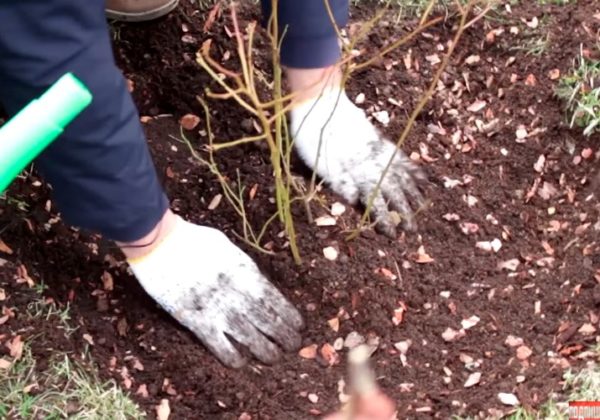

Landing
Step 5
Water the soil.
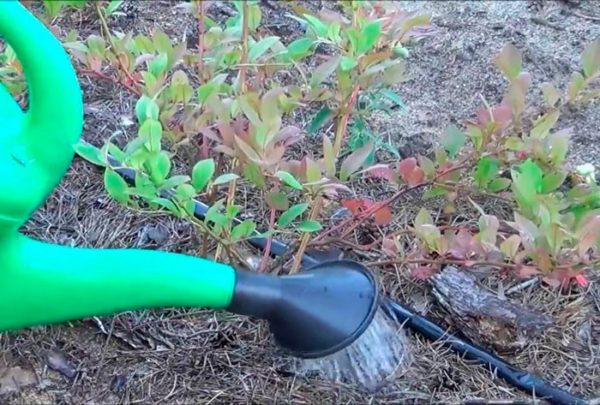

Final watering
If the soil is unsuitable (too clayey), planting is often arranged on hand-poured ridges. For each individual shrub, you can make something like a sandbox on an elevation, which is convenient to do in small areas.
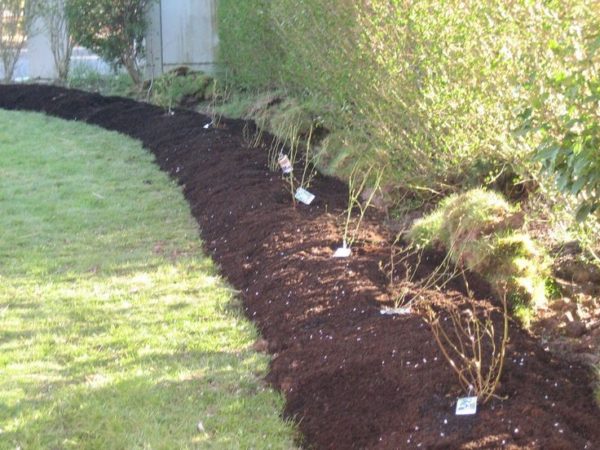

Disembarkation on a dais
Video - Garden blueberries: planting and care
Where grows
In cultivated form, blueberries can be found in almost every part of the world. It grows into:
- Russia - especially in Novosibirsk, in the upper belt of the Urals, Moscow region, Leningrad, Volgograd, Arkhangelsk regions, in the Far East, Siberia, Tundra;
- in North America, along the strip from Alaska to California;
- on the islands: British, Japanese, Iberian Peninsula, Iceland.
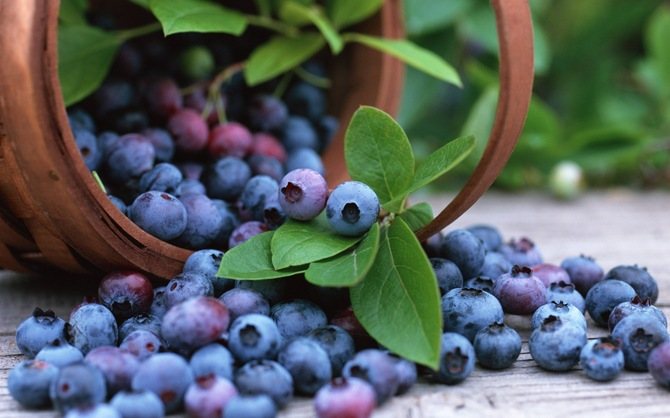

Garden blueberry appearance
Those who are interested in where blueberries grow should be aware that different varieties of it can be found in every region of Russia, as well as in almost every region of Ukraine and Belarus.
How to care for blueberries?
Blueberries are a very unpretentious culture. The most important thing is to provide it with moisture, especially during the periods of bud formation and fruiting - from mid-summer to early autumn.
For irrigation, you should not use plain water, but a solution with some kind of organic acid, for example:
- sorrel (lemon is also suitable) - in the proportion of one small spoon for three liters;
- vinegar - 200 milliliters per ten liters.
Experienced owners use electrolyte for batteries, preparing a solution with its use - 10 milliliters per 10 liters of water.
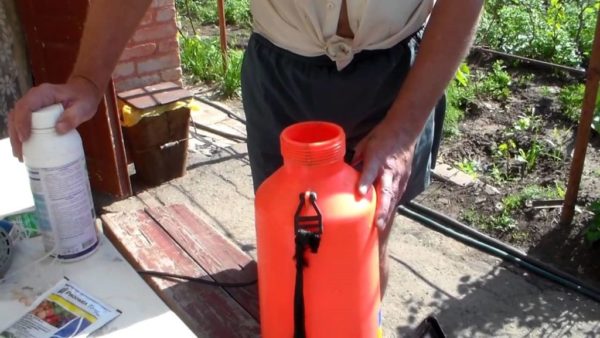

Preparation of the solution
Care features
For standard feeding, it is recommended to use mineral or organic fertilizers: sphagnum moss, pine needles. The shrub bears fruit for about two to three months, the berries hang on the branches for about 10 days. One plant produces 3-6 harvests during the summer.
Blueberries most commonly suffer from the following diseases:
- stem cancers;
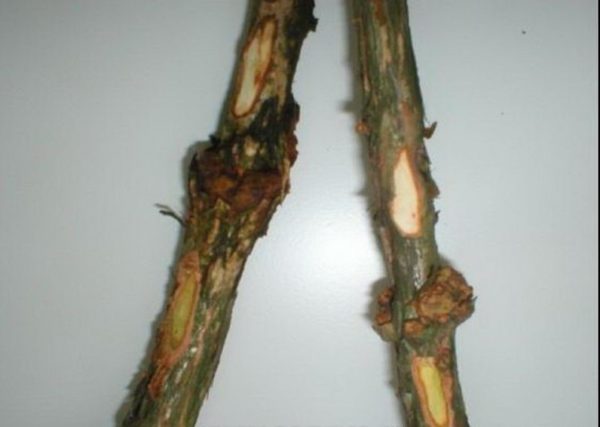

Cancer
- late blight;
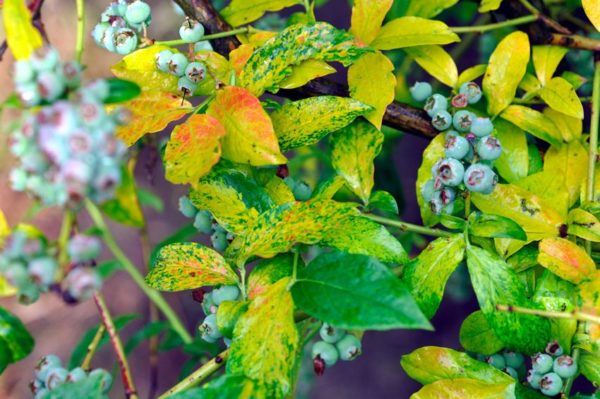

Late blight
- monilial burn;
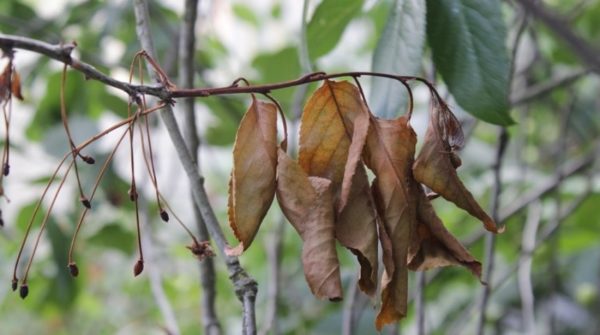

Monilial burn
- and other diseases.
To combat ailments, conventional formulations for shrubs are used. To ensure that the bushes are protected from diseases, they are sprayed in the spring months - at the end of the pruning process.
The average minimum temperature that most blueberry varieties tolerate is about minus 24-24 degrees. If in winter there is not enough snow, the risk of freezing the roots is great. Late-ripening shrubs especially often suffer from early frosts. It is recommended to cover them with burlap or similar (air-permeable) materials.
Preparation for wintering:
1. The branches are bent closer to the surface of the earth, after which they are fixed with ropes or wire; 2. Insulation is laid on top of the bushes (it is not recommended to stretch the film). It does not hurt to additionally throw on spruce branches, and when snow appears, add it too. With the departure of frost, the shrubs release and cut off the ends of the frozen branches.
Pests
Insects that eat leaves and buds and feed on plant sap can cause minor harm to tall blueberries.
It can be:
- pine silkworm caterpillars;
- leaf rollers;
- scabbards;
- aphid.
Chemicals are used against insects; it is enough to collect the caterpillars by hand.
More damage can be caused by birds that attack berry growers during the ripening period of the crop. For protection, the blueberries are covered with a fine mesh, shiny objects are attached to the branches, and sound cannons are installed.


When should you prune blueberry branches?
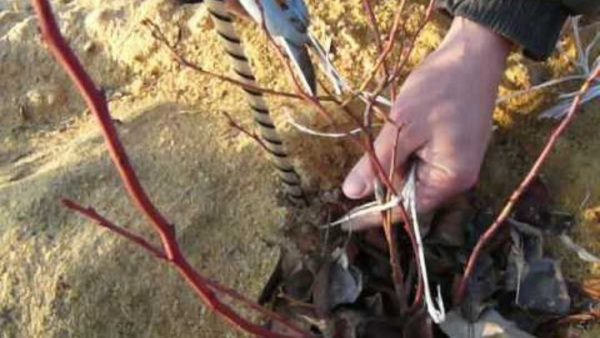

Pruning branches
The pruning process takes place during the spring months. For the first time, this should be done after the bush is 2-4 years old. This is necessary for the correct formation of a strong skeleton.
The procedure is reduced to the removal of branches with buds. The next time, the branches should be cut when the bush reaches 5-6 years. It is necessary to cut off old and diseased branches, as well as growths at the base.
Video - How to trim blueberries?
Diseases
The most common and similar in appearance is stem cancer and drying out of branches. Also, blueberries are affected by such a common disease as gray rot. To combat fungal diseases, three times spraying of plants is used before and after flowering with a 0.2% solution of topsin or euparen.All damaged branches must be cut and burned in a timely manner.
Diseases of a mycoplasma or viral nature pose a great danger to varietal blueberries. These include red and necrotic spotting, dwarfism, mosaic. Such diseases are extremely rare, but when they are diagnosed, the plants must be destroyed.
Preventive means of combating pathogens that cause blueberry disease are elementary agricultural techniques. Thanks to regular weeding, soil mulching, timely watering and fertilizing, the plant will fully develop and be able to resist diseases.


Top dressing
As soon as 2 years have passed after planting, the soil composition should be adjusted.
Table 1. Signs of a lack of various useful elements in blueberries
| Item name | Visual signs |
| Phosphorus | The leaves turn red and are pressed against the stem. |
| Potassium | Spots are visible on the leaves, and their tips die off. The upper parts of the shoots turn black. |
| Calcium composition | The ends of the leaves turn yellow, and they themselves are deformed. |
| Magnesium | Reddish edges at the leaves, near the midveins, the normal (greenish) color remains. |
| Boron | The leaves noticeably turn blue, yellowness appears between the veins of the old leaves, shoots die off. |
| Iron | New leaves turn yellow, while a green mesh of veins is clearly visible. |
| Sulfur | The leaves turn white-yellow or completely white. |
| Nitrogen | The growth of shoots is greatly slowed down, old leaves turn yellow, and later acquire a red tint. The berries are getting smaller. |
The amount of fertilizer applied per shrub (in tablespoons):
- 2 years old - 1;
- 3 years old - 2;
- 4 years old - 4;
- 5 years old - 8;
- If the bush is more than 5 years old - 16.
Experts advise feeding in the first spring month - when the buds begin to swell (the juice begins to move).
Important: Zn, Mg and K sulphates should be applied only once a year.
Delicious and healthy berry
Blueberries are a shrub that grows up to 1 meter in height. In high-altitude places it grows as a low shrub. Shoots are oblong, pubescent in the initial period of growth. Leaves are elliptical, slightly folded at the edges, bluish-green, matte on top.
Green or whitish flowers appear on the tops of the lateral branches. Blooms in May. The berries are spherical, purple-black, with a blue waxy coating.
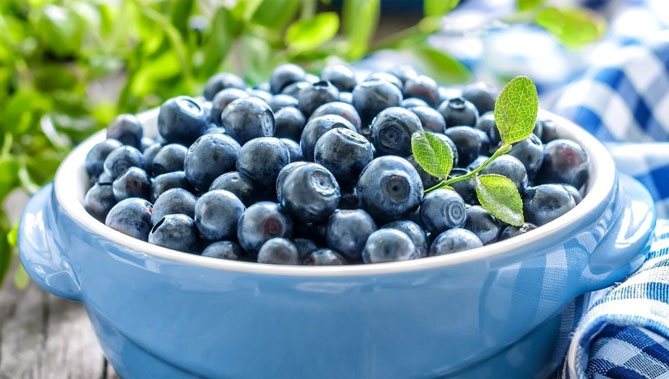

The shrub grows in swamps, in swampy forests, on infertile soils containing little humus. In the mountains it grows at high altitudes. The berry has excellent taste and nutritional value and is rich in vitamins. It is important to know how to plant blueberries correctly, prepare the soil for planting, how to care for blueberries.
Features of the reproduction of blueberries
You can use seeds, cuttings, and apply propagation methods by dividing the bush or layering. The most recent method is the simplest.
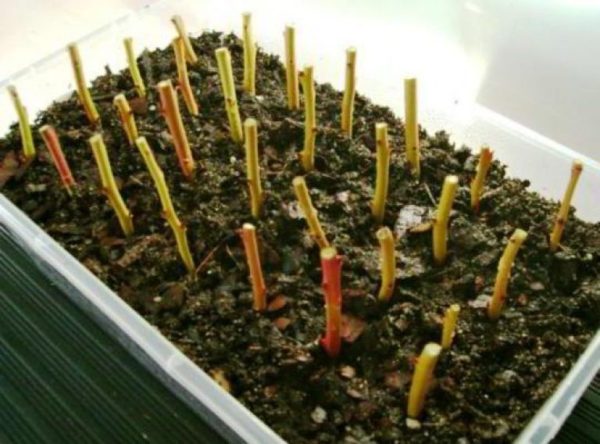

Propagation by cuttings
Separate branches are placed on the ground, covering them with sawdust near the base. After two to three years, roots may sprout. The branch is cut off from the bush and planted separately. If there is a risk of damage to the seedling by pests, it is allowed to use special chemicals, for example, "Spark - double effect".
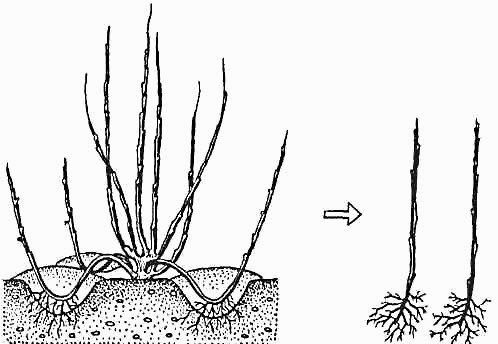

Reproduction by layering
Landing scheme
- The distance between bushes for low-growing varieties is 50 cm, medium - 1 meter, tall - 1.5 m.
- Keep the step between the rows 2 m. This will make it possible for the blueberries to receive sufficient illumination.
- The seat is prepared with a depth of 50 cm, a width of 80.
- It is good to use the soil of coniferous forests with the addition of bark, pine branches and sphagnum moss. If the soil is heavy, river sand is added to the bottom of the pit.
- You cannot use organic matter and ash.
- It is enough to add mineral fertilizers and soil acidifiers.
- Spread the root of the plant and plant it down in the form of a fan.
- The root collar is deepened by 7 cm.
- Sprinkle the blueberries with soil and press down slightly.
- The seedlings are watered abundantly.
- The next step is mulching with pine sawdust or pine needles.
Common mistakes when growing garden blueberries
Although blueberries are not considered a moody plant, breaking a number of rules can severely damage the shrub.
One of the most common mistakes is choosing the “wrong” seedlings when planting. They must be absolutely healthy, which can be determined by the leaves (without spots), if they are not there, you need to look at the bark: if there are brownish (or burgundy) spots, the seedling should be set aside.


Sick bush
Plants with bare roots cannot be purchased, they must be in a container (pot) with the appropriate soil. Before planting, be sure to soak the root (from 30 minutes to 2-3 hours), otherwise you will have to forget about the harvest.
It is very important to carefully prepare the soil for blueberries: the bush may not tolerate the wrong composition - the presence of ash, manure or bird droppings in it.
If you choose the wrong place for planting, the result can also be disastrous. There should be enough sun and as little winds as possible, from which the bark deteriorates on the bushes, and various infections penetrate into the wounds. Also, due to the effects of bad weather, some properties of the berries are lost: for example, they deteriorate during storage much earlier.
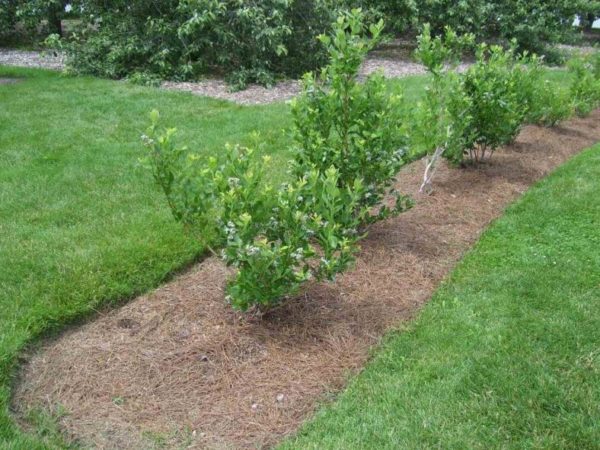

The place must be sunny
It is important to understand that blueberries tolerate the dry period much calmer than excess moisture. Excess water accumulating near the roots deprives them of the required amount of air, the bush begins to choke and dies.
Around the seedlings, it is recommended to mulch the surface with sawdust - a layer a little less than 10 cm thick is enough. This will prevent weeds, help regulate the temperature and air-water regimes: the soil will stop overheating and dry out.
Advice: if the soil is clayey in the area, a good solution would be to create a drainage system before planting, and then you can start digging wells.
Care
Caring for blueberries in spring and autumn involves several important activities: watering, feeding, pruning, wrapping, pest control and disease control.
- Watering. Good fruits will be provided if the plant is watered at least twice a week. In a hot period, you need to spend 2 buckets of water for one bush: 1 in the morning, 1 in the evening. Most attention should be paid to this activity during the flowering period of the plant and the appearance of fruits, as well as if there are obvious signs of moisture deficiency (yellowed or twisted leaves);
- Top dressing. Although blueberries are usually an unpretentious plant, they should be fed in early spring, as well as during the period of swelling of the buds and the appearance of fruits. The best means for this purpose will be: potassium sulfate, zinc sulfate, ammonium sulfate, magnesium sulfate, superphosphate;
- Pruning. Even before the buds begin to swell, every spring it is necessary to remove by pruning any shoots that have become frostbitten during the winter, as well as damaged, dry or too thin. This will help form a strong skeleton for the bush. There may be more pruning during the year if the bush is sick or injured;
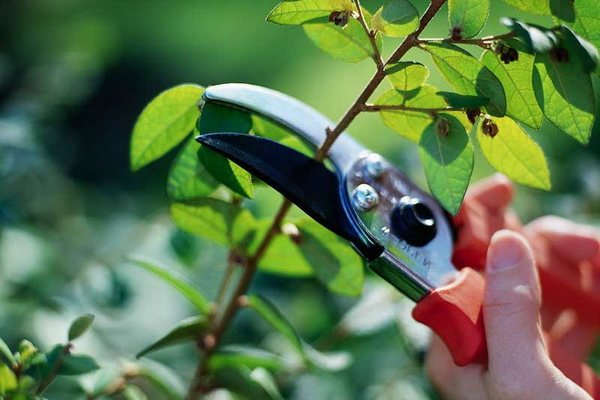

Pruning garden blueberry shoots
- Wrapping. Should be carried out in areas where there are severe frosts. The procedure is performed after harvesting. With the help of twine, the branches of the plant must be carefully bent to the ground, spread out on the site and fixed. You can cover the plant with burlap, and then spruce branches. Open only in spring.
Important! Blueberries cannot be covered with plastic wrap for the winter, because it interferes with air circulation and thus causes the death of the plant.
As for pests, birds most often eat blueberries. You can protect the fruits from them with a thin light mesh. Blueberries can be protected from caterpillars and insects by spraying with actellik or karbofos.
Most often, blueberry bushes suffer from fungal diseases. This is a consequence of stagnant moisture at the roots of the plant.Among the most popular diseases are: physalsporosis, botrytis, double spotting, stem cancer, monoliosis of fruits and others. It will be possible to save the bushes from such ailments thanks to the treatment with topaz and the Bordeaux mixture.
Storing and using blueberries
Under normal conditions - a temperature of + 20-25 degrees, the berries will deteriorate in a couple of days. The refrigerator will extend the period for a few more days.
The easiest way to store for a short time is to rinse the blueberries, dry them and carefully place them in glass jars - in this form, the crop can be kept for up to a week and a half.
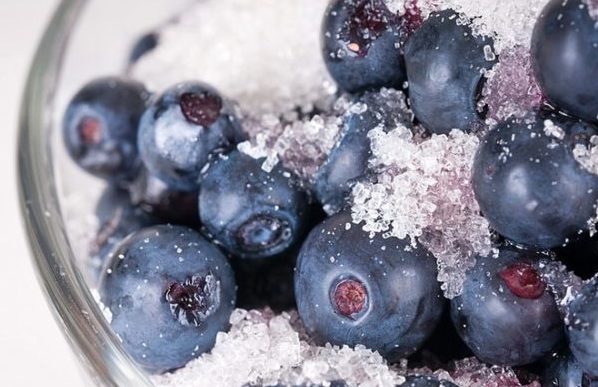

Blueberries in sugar
Common methods for preparing blueberries for long-term storage:
- Freezing - starts with sorting the fruit. Further - rinsing in running water. Drying - if you freeze wet berries, then their taste will deteriorate significantly, and the skin will be tough. After that, the berries should be placed in a container, but leave a gap between the top layer and the lid - about two centimeters. Be sure to sprinkle a little sugar on the blueberries. Now you can close the lid and place the container in the freezer, where the berries can be stored for a very long time; 2. Soaking in water - the berries are washed, placed in jars and filled with cold boiled water. After that, the blueberries should be boiled for about ten minutes, if small jars (0.5 liters) are used, and if large (liter) jars were taken, then the boil is carried out for about 20 minutes. Banks need to be rolled up and placed on the shelves in the cellar or refrigerator upside down; 3. Candying - washed blueberries are driven through a meat grinder, and sugar is added to the resulting gruel - 0.5 kg per 1 kg of berries. Everything is mixed and heated over the fire. Banks should also be warmed up and pasteurized. Transfer the resulting mixture to jars and roll up. Storage - in a refrigerator or other cool place, period - about a year; 4. Drying - The easiest way is to use a conventional oven. Clean and dry berries are poured onto a baking sheet in a thin layer. The temperature should be set in the region of 40-50 degrees. Place the baking sheet in the oven, but do not close the door completely. Blueberries are dried for 1.5-2 hours at 50 degrees, and then another hour at 60 degrees. You can store it in tightly closed containers for several months (either in the refrigerator or in the cellars).
Some gardeners use blueberries to make homemade wine.
Harvesting is recommended at least 1-2 days before the start of preparing the berries for storage.
Beneficial features:
- iron, which is part of blueberries, is absorbed by almost 100%, which has a positive effect on human immunity and endurance;
- recommended for people with diabetes mellitus, as it can increase the effectiveness of drugs that reduce sugar levels;
- restores metabolic processes;
- helps break down fats;
- the elements that make up blueberries help to strengthen the walls of blood vessels, improve blood formation;
- use in any form has a good effect on the work of the digestive tract, the nervous system.
The berry is especially useful for people who are fond of diet food, since its calorie content is low.
conclusions
- Garden strawberry is a berry shrub, some varieties grow up to 2 m in height. For growing in the garden, an ordinary and tall variety are used.
- Planting is recommended with grown seedlings. When choosing a location, dry areas with high-quality diffused light should be preferred.
- The seedlings are placed in individual pits up to 50 cm deep. The nutrient mixture should be placed on the bottom. The distance between the bushes is 0.7-1.0 m.
- Blueberry care includes regular watering, soil management, feeding and pruning. In the north, it is advisable to cover the plant for the winter.
Selection of plant seedlings
Choosing blueberry seedlings is a top priority.It is necessary to carefully examine the plants before buying: it is important that there are no spots on the leaves, the leaves themselves are green. When buying in early spring or late autumn, the bark is closely examined - the presence of red-brown and red spots indicates a plant disease.
If no defects were found during inspection, but before planting they appeared, it is necessary to cut off the affected areas to healthy tissues, process the cut and then plant it like a healthy seedling.
Buying a seedling with an open root system does not make sense - the plant will not take root. It is best to choose seedlings in a container or pot filled with acidic soil.
You can grow seedlings yourself, from seeds, but this will require hard work, perseverance and tremendous effort, since the seedlings are grown for two years, and for germination of plants the seeds are cold treated. After planting, before pecking the first leaves, it is necessary to keep a stable temperature from 23 to 25 degrees, humidity at least 40%, plus constant loosening, watering, feeding and processing of young plants from pests and diseases. Additionally, you will have to reject all weak plants, prune diseased seedlings ... That is, for a gardener without experience, it may be an overwhelming task, and an experienced gardener may well grow beautiful blueberries from a seed.
Site selection and preparation
Illumination of the site and groundwater
- To grow blueberries, choose a place well-lit by sunlight, perhaps light shading, but the berries will taste sour.
- Avoid the close occurrence of groundwater - they must pass at a depth of more than 1 meter.
- It is desirable that the site be protected from drafts and strong winds.
Soil composition
For blueberries to successfully take root and bear fruit, you need an acidic or slightly acidic soil. A mixture of peat and sand is ideal. Can be grown on clay soils, provide good drainage. The necessary "ingredients" are brought into the planting pit.
Predecessors and preparation of land for planting
The plant does not like its predecessors. It is good if the ground is fallow for a couple of years before planting blueberries.
1 month before planting, prepare the site: for digging, add organic matter (rotted manure, compost) and a complex of mineral fertilizers. If planting is planned for the spring, it is best to do it in the fall.
Distribution and growing conditions
The shrub can be found almost throughout Eurasia, North America, northern Japan, Iceland, etc. Wild blueberries are widespread in places far from industrial enterprises and large cities.
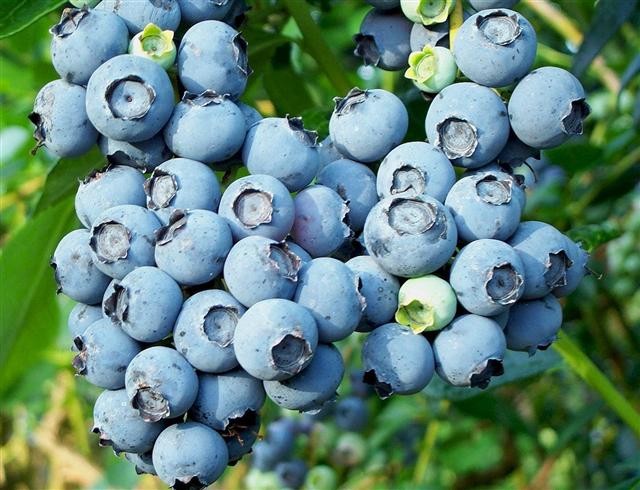

Blueberry bush
The plant chooses swampy soil, peaty, acidic soil, coolness, moderate humidity. It lives in a variety of places: mixed forest, swamps, peat bogs, mountains, tundra, forest-tundra. Blueberries, like blueberries, rarely grow in one bush, they usually settle in large groups. Many residents of villages located in Siberia, the Urals, the Far East know the places where berries like a carpet cover huge meadows or the banks of small rivers and lakes.
Interesting! It is noteworthy that blueberries are one of the few berries that can grow normally where there is practically no soil. For example, in mountainous areas, on bumps in a swamp, on mosses in permafrost, etc.
If we talk about garden culture, then it can grow almost anywhere throughout the Earth. Cultivated blueberries are unpretentious. She is satisfied with the short summer, lingering cold weather, rains, heat. However, not all crop varieties are suitable for different territories.
Frost protection for blueberries
The aerial part of blueberries is still sensitive to cold temperatures. Within -18 ..- 20 ° С, young tops, and with prolonged snowless low temperatures - and the entire aboveground mass, can freeze out.To prevent this from happening, for the winter the plants are bent as far as possible so as not to break the branches, and they are covered with burlap or lutrasil. Film cannot be used. Spruce branches or loose snow are thrown onto the shelter. In the spring, after removing the shelters, before the buds swell, sanitary pruning is carried out, removing the frozen tops of the stems.
Transplanting an adult blueberry to a new location
The need to transplant an adult plant to a new place is dictated by several reasons. In particular, this is done in order to exclude diseases or improve the quality of fruiting, etc.
In a new place, the bush is planted at the same depth level, and they try to do everything in such a way that the plant quickly takes root and soon begins to bear fruit again.
Preparing a bush for transplanting
Before removing the plant from the soil, the shoots are revised - all old and dried shoots are removed, young stems are shortened by ½ the length.
Starting the procedure for extracting a bush from the ground with roots, they first dig around the perimeter at some distance from the trunk, trying not to damage the root part. In blueberries, the depth of the roots is about 30 cm. You need to be guided by this value, first digging in the lateral roots. When excavating, plants try to keep as much soil as possible on the roots. After being removed from the ground, it is not recommended to linger with planting.
The sooner the bush finds itself in the soil again, the more chances it has to grow faster in a new place. Most of the time is usually spent on digging, while planting in a new hole takes a few minutes.
Blueberries have very fragile branches that easily break away from the roots, so you should not pull them with special force when digging out the bush. First, they pry the roots with a shovel and then they pull out the bush.
Planting pit preparation
Be sure to dig deep into the soil in the new territory, determine the level of acidity of the soil, where the blueberry bushes will be planted. Digging a hole, observe its dimensions, they should not be less than 50X60 cm. The bottom in the hole is loosened.
The soil mixture for planting is prepared in advance. For this, the garden soil is mixed with peat in equal proportions. They also act in this way: they dig a hole, cover it from the inside with a film, fill it with peat, and put blueberries in it.
It is recommended to place the bushes in a new place according to the cardinal directions, as they grew before transplanting. You can determine the side of the bush growing on the south side by the shade of the shoots - here they are darker, as if tanned. But the side of the plant that grew from the north, on the contrary, looks paler (lighter).
Transplanted plant care
After transplanting, the blueberries are watered abundantly. Then watering is carried out constantly, not allowing the soil to dry out. However, during watering, moderation is observed, the soil is not overmoistened much. Watering is combined with dressing, adding in equal proportions (1 tsp each) superphosphate and potassium sulfate (in summer), nitroammofosku - 1 tbsp. l. (in the spring).
If blueberries are planted correctly (in sour, loose, nutritious soil), watered in a timely manner, they will delight with the harvest already, three years after planting. And it will give tasty and healthy berries not only to those who planted it, but also to their descendants. After all, the lifespan of this culture is about 90 years.
Planting material
For planting, it is preferable to choose seedlings with a closed root system (in pots, containers). Even under these conditions, be careful not to damage the root system. Some gardeners recommend replacing the soil in which the seedling grew. Remove the seedling (along with the earthen lump) from the container, immerse it in water for about 15 minutes, carefully separate the soil and then plant it (do this only if the soil in the pot is transportable and you have doubts).
Growing blueberries from seeds at home
Can blueberries be grown from seeds? Of course yes! Growing blueberries from seeds is a fun but time-consuming process.
How to collect seeds
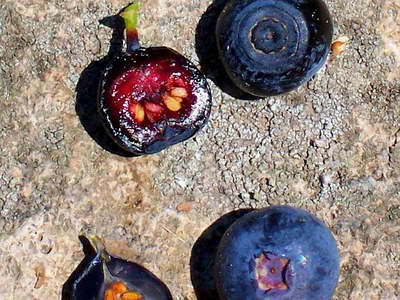

What do blueberry seeds look like?
The seeds can be purchased or harvested by yourself. Take fully ripe fruit to harvest the seeds. Knead them thoroughly with your hands until a soft mass is obtained, which should be washed with water. It is best to do this in a saucer, the seeds will remain at the bottom. Spread the resulting suspension on special filter paper and dry well. Seeds germinate for about 10 years, they should be stored in a paper bag.
Blueberry seed stratification and preparation for sowing
You can sow blueberry seeds immediately after drying. If you are postponing sowing for the spring or longer, the seeds will need to be stratified. Toss them with damp perlite and place in a tight-fitting bag. Store in the vegetable section of the refrigerator for 2-3 months. Check the humidity at intervals of 10 days, if necessary, spray from a fine spray, do not overmoisten.
How to plant garden blueberry seeds
- Take a peat seedling tablet, fill (about 50 ml) with warm water to swell (it should increase in height by about 5 times, keeping the original diameter).
- Fully deepen the seeds (together with perlite) into the peat pellet.
- Then fill the pot or container with fertile soil, make a depression and place a peat tablet, its surface should be about 2 mm under the soil layer, spray with a fine spray.
- Can be sown in a sand-peat mixture in a ratio of 1 to 3. Spread the seeds over the surface of the soil, only slightly pressing into the soil, moisten by spraying.
Crop care
Cover the container with crops with foil, ventilate daily, eliminating condensation. For germination, bright diffused lighting is required, the air temperature should be kept in the range of 23-25 ºC, the soil should be constantly slightly moist (spray from a fine spray 2-4 times a week). The germination process takes 7-30 days. If mold appears, it is necessary to treat it with a fungicide. It is better to remove the shelter as soon as the first shoots appear. Continue to moderately moisturize, with the appearance of 2 true leaves, plant in separate containers. For good growth, water with a solution of mineral fertilizers every 14 days (1 tablespoon of Kemira Lux for 10 liters of water, 1 liter of solution is required for 1 m²).
After fertilizing, wash the leaves with plain water. In the spring, seedlings are planted on a test bed, where they will grow for about 2 years. Caring for them consists in regular watering, removing weeds, loosening the soil, periodically feeding them with mineral fertilizers. Then transplant to a permanent growth site. The first berries can be tried after about 2-3 years of growth, the maximum fruiting begins from the 7th year of growth.
Due to the laboriousness and duration of growing blueberries from seeds, vegetative propagation methods are most often used.
Gardeners reviews
The varieties that I have: Bonus - the largest-fruited. Berries up to 3 cm in diameter! I do not know more large-fruited. The taste is very good. Elizabeth. The berries are large, up to 2 cm in diameter. For my taste, this is the most delicious variety. A very harmonious ratio of sugar and acid. Patriot is the most frost-hardy or one of the most frost-hardy blueberries. -37 suffered without freezing, all the rest had freezing of the ends sticking out above the snow. Stably productive variety. The first berries in the cluster are especially large, up to 2 cm in diameter. Spartan and Northland are not bad varieties, they taste not bad either, but I will not say anything special about them.
Sentient dolphin
Today the blueberries have had a bad winter, one bush has died. And she sheltered, and the winter was warm. I don't even know what they lacked.And our summer this season looks more like autumn, it is especially cold at night, it is very difficult for all thermophilic people, only cabbage, onions and carrots get high.
Sweet tooth
In the Moscow region, the winter was relatively warm, but little snow. The ground is very frozen. Then the early spring heat, then the cold ... The blueberry burst into bloom, and its root is still in an ice lump. Until I realized this, individual bushes have lost more than half of the flowering branches. Biological drought. The soil under the blueberries is light, water-absorbing and an excellent heat insulator. Now in the spring I will specifically watch. You may have to melt the ice with heated water (although I know that this requires a crazy amount of energy).
MikhSanych
I have one bush growing for 10-11 years already. Bluecrop variety. Rocked slowly. I planted a second variety for pollination. It was clearly better, but dried out. The birch grows nearby. It responds well to the ground from the forest, took it from under the pines. This year it was very large and tasty.
Alexander-Shuvalovo
A large selection of blueberry varieties bred by domestic and foreign breeders contributes to the growing spread of the culture. Despite some finickyness of the plant, even novice gardeners can grow a bush and harvest a crop.
Popular varieties
In central Russia, the most popular varieties are:
- Weymouth.
- Rankocas.
- Jersey.
- Dixie.
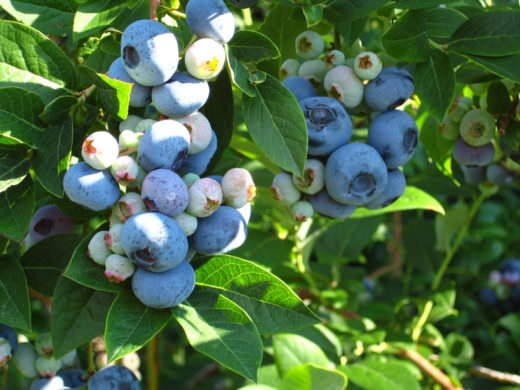

Weymouth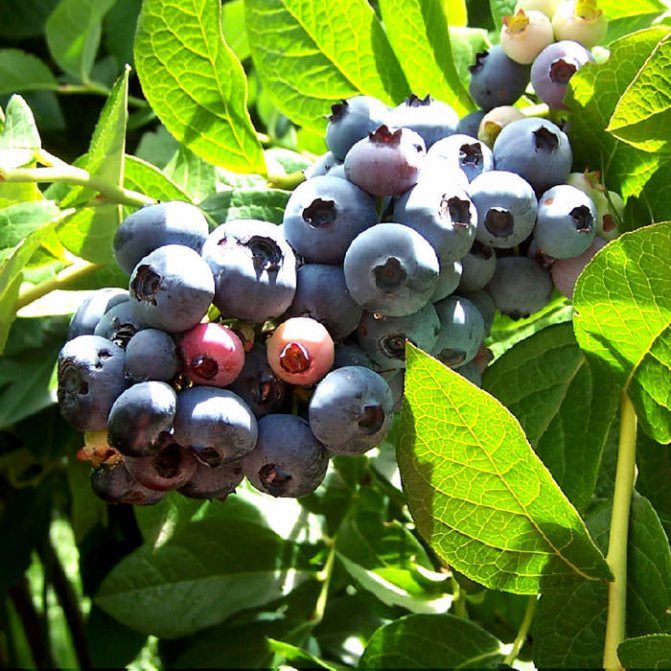

Rankocas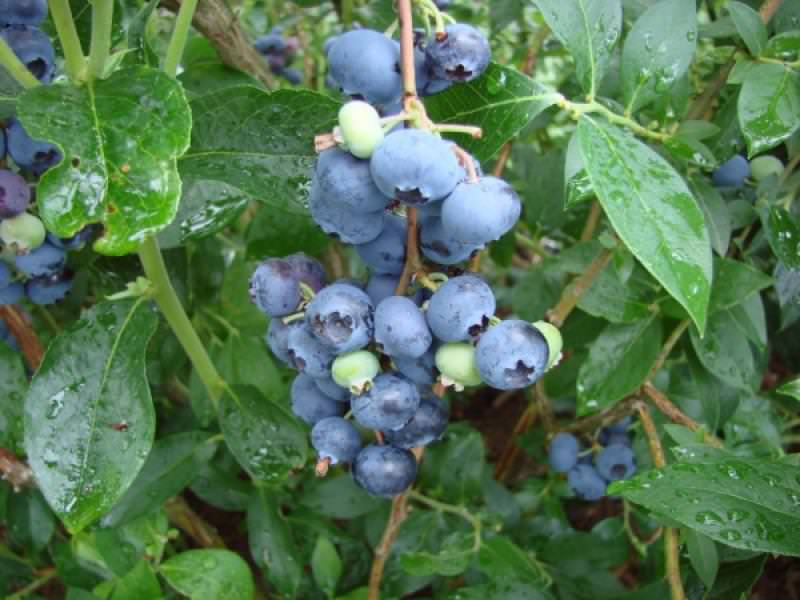

Jersey
All varieties bear fruit every year. The fruits form a multi-berry cluster. They resemble small-fruited cherries in size. Winter is tolerated satisfactorily.
Varieties that are distinguished by their winter hardiness:
- Duke.
- Chippewa.
- Patriot.
- Bluegold.
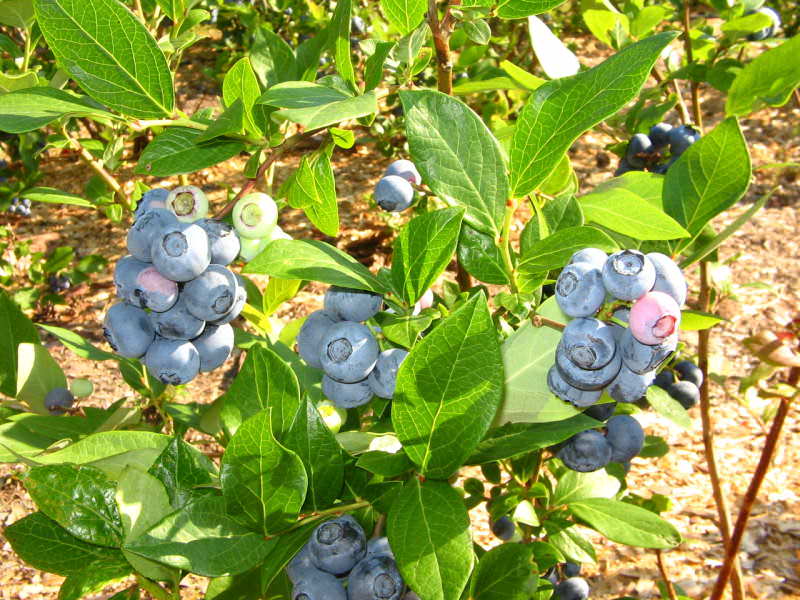

Duke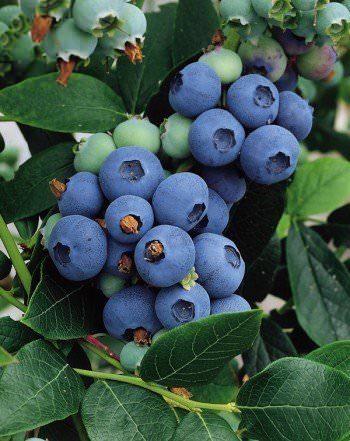

Chippewa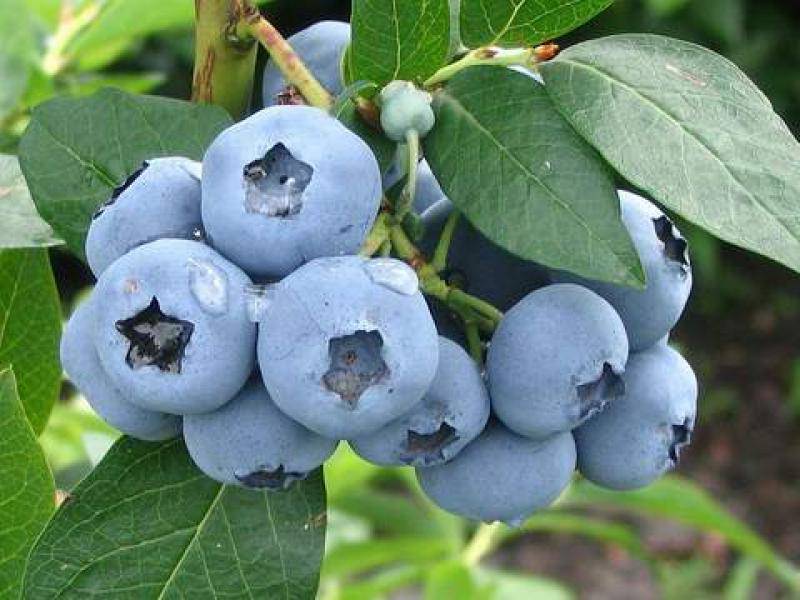

Bluegold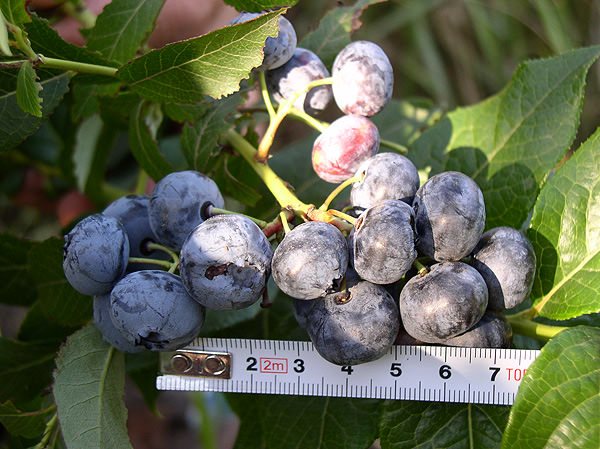

Patriot
The listed varieties are tall and medium-sized species.
Blueberry harvest
Blueberry flowers easily tolerate short-term frosts down to -7 * C and therefore do not need special protective shelters.
Early blueberry varieties form a harvest in technical ripeness by the first ten days of July, middle and late ones - with a lag of 1-2 weeks. The external manifestation of the ripeness of the berries is a blue-violet color with a waxy bloom. Ripe berries are easily separated from the brush. Ripening is gradual. The berries fall off after a 2 week waiting period. Cleaning ends by the end of August. Adult bushes form up to 5 kg of berries.
The berries are kept fresh for 4-5 weeks. They are used fresh and processed. They prepare compotes, juices, preserves, jams, etc.
Storage of seedlings before planting in the ground
You can buy blueberry seedlings in containers already in February. At the same time, it is important to understand that until April-mid-May, that is, until the moment of planting in open ground, they will have to be stored. First of all, as soon as the seedling is at home, it is recommended to spill its root system with a fungicide preparation (Fundazol, Vitaros, Fitosporin, etc.), which is prepared according to the instructions. After that, the seedling is transplanted from a purchased container into a more spacious pot, filled with sour high-moor peat. In this case, the removal of the seedling from the container is carried out together with the earthen lump. Next, the pot with a bush is placed in a cool, but always bright place, in which it is stored until planting.
Video: How to preserve blueberry seedlings before planting on the site in spring
If blueberries are already growing in the garden, it is possible to breed a few more bushes, taking material for planting from the parent plants. In this case, all young plants that take root will be endowed with the properties of adult bushes. Cutting is the most common breeding option for any fruit unit. However, in order to implement it, gardeners harvest shoots from autumn or already in winter, which will have to be stored for some time until they are used.
To do this, the material is wrapped in polyethylene and placed in a cool and unlit place (in a basement, cellar, closet). In April, shoots are taken out and cuttings are harvested from them (parts of shoots 15–20 cm in length) with a straight upper cut and an oblique lower cut. After that, the planting material is rooted in a soil mixture of peat with sand (1: 1). Cuttings are grown in a warm greenhouse or indoors. In open ground, the planting of the cuttings is planned for September - October.
Recent Entries
Gardener's lunar calendar for 2020: we do it right 3 reasons, make a reservoir in the country: we plan a new season Note for gardeners: 7 useful things to save energy
Site requirements
For the berries of the plant to gain sweetness, they need a lot of heat and light. Therefore, planting garden blueberries is optimal in places open to sunlight. It should be borne in mind that the shrub reacts poorly to drafts. The site should be carefully protected from them by walls of buildings or a hedge of trees. Bluecrop and Patriot varieties can grow in the shade, their leaves will not suffer from it, but in this case, the berries collected from them will turn out to be sour. The lack of light will also negatively affect their quantity.
Loose well-drained soil with low groundwater table is preferred for blueberries. It will be correct to plant it on peaty-sandy or peaty-loamy soils. It is worth remembering that such soil is rich in nitrogen. Due to the increased content of this element in winter, plants can freeze out, and with the arrival of spring, their thawing will take longer than usual. Shrub develops well exclusively in acidic soil with a pH in the range of 3.5-4.5.
It is important that no other crops have been bred before on the site where blueberries are to be planted. If there is no such site in the garden, the soil suitable for the shrub will have to be prepared independently according to the following rules.
- Loamy soil is diluted with sand and high-moor peat, mixed in a ratio of 1: 3.
- Sand is added to acidic peat soil at the rate of 2-3 buckets per 1 m².
- If the land on the site contains little organic fertilizers, complex mineral preparations containing equal amounts of nitrogen, phosphorus and potassium are introduced into it.
- In the soil enriched with humus, the same mineral elements necessary for the full development of blueberries are added, but in a ratio of 1: 2: 3.


Weeding and mulching
The roots are close to the surface, so all work should be done as carefully as possible.
Weeds are removed as soon as their shoots appear. Mature plants have large taproots that suck up moisture and nutrients.
Mulch will protect the plantings from moisture evaporation, overheating and weeds.
Instead of straw and spruce branches, you can sow the aisles with green manure and mow them periodically.
Siderata fight weeds and repel harmful insects.
Fertilizer
- In the second decade of April, the first fertilizing with nitrogen fertilizers is applied. They stimulate the growth of blueberries.
- The second and subsequent dressings are applied after 5 weeks.
- Fertilizers containing nitrogen are stopped in June at about 20 days. In order not to provoke further growth of young branches, otherwise they will freeze slightly in winter.
- Special fertilizers for blueberries are popular Target and Florovit... They are complex multicomponent fertilizers.


Target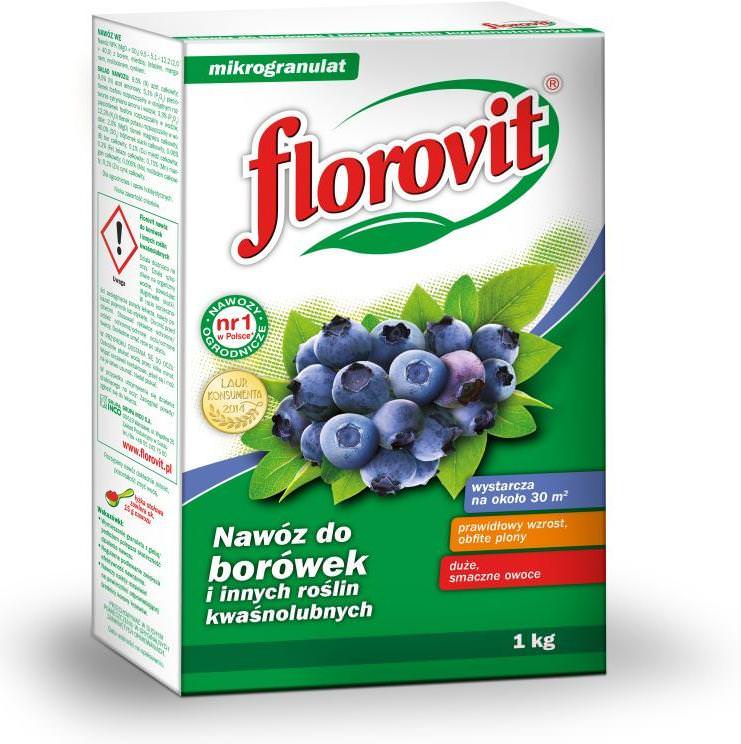

Florovit - 1 kg of packaging is used for an area of 30 sq. m.
- Top dressing can be applied in various ways: dry and diluted in water.
- When self-cooking, you will need the following components: potassium sulfate (40 g), superphosphate (110 g), ammonium sulfate (90 g).
- Dosages: 40-50 g of this mixture for a bush that is 4 years old, three - 30-40 g, two - 20 g, one - 10 g. Adult specimens over 5 years old - 80 g of the mixture. A tablespoon can serve as a measure, it contains 10 g.
If the soil is poor, the dosage is increased by ½ part, rich - decrease by the same part.
Pruning
Blueberry bushes trimmed annually... This has a beneficial effect on the green mass and ensures good fruiting.
- Pruning time is early spring and autumn. In spring, this is done before sap flow, and in autumn - after leaf fall.
- To form the crown, the main branches are cut, and the shoots are cut and the lower ones are removed.
- When the plant begins to bear fruit, regulating pruning should be done. That is, fruit buds and inflorescences should be left evenly.
- Rejuvenating pruning is carried out at 8 years of age... Removal of damaged and weak shoots is underway.
- Removal of large branches under the root is carried out after 5 years.
- Strongly growing shoots are pinched at the end of summer.
- At the ends of the shoots, bunches of small twigs are also removed.
From the history of the cultivation of tall blueberries
North America is considered the birthplace of wild blueberries. Varietal culture appeared at the beginning of the last century in the United States. In 1906, a team of scientists led by biologist Covill developed the first Brooks and Russell varieties from wild blueberry varieties. And by 1937, biologists had already created 15 varieties.
A wave of interest in blueberries has gradually spread to other countries. In 1926, Canada took over the variety testing baton. The history of the experimental introduction of tall blueberries in our country dates back to 1964.
Lack of mineral nutrition
Artificial growing conditions do not always correspond to the culture's request. When forming a crop, blueberries require increased amounts of mineral nutrition. Their lack immediately manifests itself in the appearance of plants.
Lack of nitrogen - Young blueberry leaves turn yellowish-green, and old ones turn reddish. Plants do not develop well aboveground mass.
Lack of phosphorus - As in other crops, the lack of phosphorus in blueberries manifests itself in reddening of the leaves. The leaf blades are closely pressed against the shoots.
Lack of potassium - With a lack of potassium, the tops of young blueberry shoots and the tips of the leaf blades turn black and die off.
Along with the main nutrients, blueberries react negatively to the lack of other macro- and microelements, especially calcium, boron, iron, magnesium, sulfur.
Lack of calcium - With its lack, the edges of blueberry leaves turn yellow, and the leaf blades lose their clarity and shape.
Boron deficiency - Boron is essential for blueberry plants. With its lack, the young apical leaves of the culture acquire a bluish tint, and in the old ones the interveinal spaces on the leaf blade turn yellow. Blueberry stems gradually die off. There is practically no annual growth. Plants can be treated with boron separately. Top dressing is used by foliar application through spraying plants.
Lack of iron - The deficiency begins to manifest itself with the apical leaves of the blueberry. The leaf turns completely yellow, leaving a net with green veins.
Lack of magnesium - The blueberry leaf takes on an unusual color. The edges of the leaves are red, but a strip of green remains near the veins.
Lack of sulfur - With a lack of sulfur, blueberry leaves turn white. The transition of colors - from green to yellowish-whitish and white.
If any change in the color scheme of blueberry leaves is manifested, it is necessary to carry out foliar dressing with a solution of trace elements through spraying.


